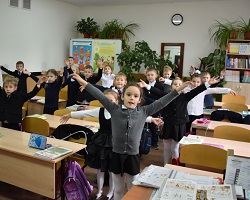Experts call for bold action on school-based health in the Russian Federation

WHO
National and international policy experts on healthy nutrition and physical activity in schools have called for bold action to promote the health of school-aged children and to invest in a future where all children have the freedom to lead a healthy and active life.
Countries at the centre of healthier populations
Nikita, a third-grade student from a school in Ulyanovsk, Russian Federation, presented his project “The Myths of Sweets”, explaining his findings from an analysis of the nutrient composition of different types of chocolate and marmalade available on the market.
Following a simple yet effective method, Nikita was able to identify that the chocolate with more natural ingredients melted faster in the palm of his hand, and that his homemade marmalade was healthier than the products he found in a store. After, Nikita treated his audience to some of his marmalade, concluding that “not all sweets are equally healthy”.
Initiatives like this one in Ulyanovsk Oblast demonstrate that it is possible to nurture cooking skills among young children and to teach them the benefits of healthy nutrition from an early age. They also show that, while the lessons focus mostly on schoolchildren, they can also benefit teachers, parents and even whole communities.
These lessons are increasingly vital. According to observations from the latest Health Behaviour in School-aged Children (HBSC) study, average prevalence of overweight and obesity (combined) across all HBSC countries and regions was at 19%, with the highest levels mainly in southern European countries. In most countries and regions and across all HBSC survey years, obesity prevalence was higher among younger than older adolescents, and was generally higher in boys.
As part of the healthy schools initiative, WHO invited 56 pilot schools from 12 Russian cities to complete a survey showcasing existing activities and environments related to encouraging healthy lifestyles among schoolchildren. The survey covered a range of indicators, including:
- access to play areas and sport/physical activities for children outside of school hours;
- the availability of free or paid for fruits and vegetables; and
- the accessibility of vending machines.
The figures showed that drinks containing added sugar could be obtained at 86% of surveyed schools, and sweet or savoury snacks could be obtained at 76%. However, the survey also showed that, on average, children in grades 1–6 spend at least 120 minutes per week in school-based physical activity lessons, and that 84% of schools have playground areas available for use outside of school hours. Furthermore, 98% of schools organize sport/physical activities for children outside of school hours.
Sharing best practices
The visit to local schools was part of a WHO workshop seeking to promote child and adolescent health in school settings. More than 100 participants, including delegates from 45 Russian schools and government officials from 12 cities of the national Healthy Cities, Districts and Villages Association, met with experts from Finland and North Macedonia as well as a joint WHO team. They took stock of strategies and policies across the WHO European Region, in particular those in the Russian Federation.
The workshop was a milestone in the WHO Country Office’s initiative to promote child and adolescent health in school settings. As Dr Melita Vujnovic said in her opening speech: “The initiative is aimed at enhancing healthy lifestyles and well-being of schoolchildren, their parents and teachers, and entire communities. It is designed and mapped fully in line with the country cooperation strategy of the Russian Federation and WHO, and in the wider context of the global health agenda.”
Participants had the chance to consider possible priority interventions to promote healthy nutrition and physical activity in schools, such as:
- implementing measures that involve parents, family and communities;
- establishing clear standards for foods that can be provided, sold or marketed in schools;
- developing intersectoral approaches that involve education, sports and health sectors; and
- including and expanding the nutrition, physical activity and health education components within the core curriculum of schools.
Tackling noncommunicable diseases
This year has been devoted to tackling major noncommunicable disease risk factors such as unhealthy nutrition and low levels of physical activity, which are common across the Region.
According to Dr João Breda, Head of the WHO European Office for the Prevention and Control of Noncommunicable Diseases, there is an urgent need for comprehensive action to improve the health of children in the Region. Engaging with multiple sectors – including the education and city planning sectors – is one of the important ways of improving children’s nutrition and physical activity habits.
These efforts will help to accelerate progress towards the achievement of better health and well-being for 1 billion more people, a goal of WHO’s 13th General Programme of Work in line with the Sustainable Development Goals.



